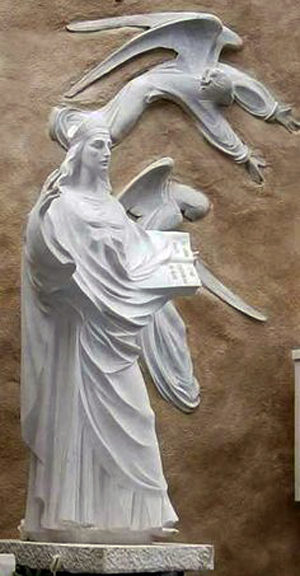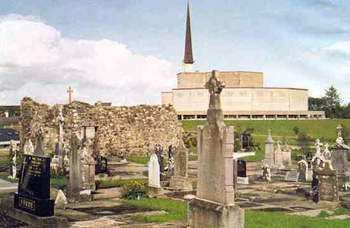St. John in the Apparition of Knock
In the sequence of this series, let us analyze today the figure of St. John the Apostle in the scene at Knock. The figure of St. John is perhaps the most interesting aspect of the Knock apparition.Indeed, it was the presence, pose and symbolism of St. John that first drew me to further study the message of Knock. Before entering the subject of St. John’s presence at Knock, allow me to present a few details concerning this special Apostle.
St. John was the youngest of the 12 Apostles. He was a virgin and because of his virtue and purity, he was often referred to in the Bible as “the disciple whom Jesus loved.” He was the one to whom Our Lady was entrusted by Our Lord himself from the height of the Cross. He was the only Apostle who did not flee, but was present at the foot of the Cross.
He wrote three small Epistles and was an Apostle who penned one of the four Gospels – hence the title “St. John the Evangelist.” He also wrote the last book of the Bible, which is the mysterious and prophetic book of the Apocalypse; hence another title, “St. John of the Apocalypse.”
Along with St. Peter and St. James, St. John was present at the Transfiguration on Mt. Tabor, the Garden of Gethsemane and other of the most significant events of Our Lord’s life.
Our Lady, St. Joseph & ‘a Bishop’
At the Knock apparition, the figure of Our Lady was immediately recognized by the witnesses and required no verbal or written proof. She appeared in the front and center, a little taller than the other two figures and was clearly the focal point of the apparition.
St. Joseph also was immediately recognized by every witnesses of that mystical phenomenon. Indeed, St. Joseph is always one of the easier figures to recognize in any Church. He usually appears tall and lean, holding a lily-flowered or plain staff and often the Child Jesus. He is normally groomed and attired as a grown man of apostolic times, markedly older than Our Lord and the Apostles. The grey coloring of his beard in the apparition at Knock was spoken of by at least two witnesses. As one of the female witnesses adroitly put it, “Everyone knows what St. Joseph looks like.”

The statue of the mitered St. John at Knock
Ever since the Knock apparition in 1879, the “Bishop” has been universally recognized as St. John, who was, in fact, the Bishop of Ephesus. This is because the third figure corresponds to the traditional representations of St. John who is always depicted as a young man with no beard, long hair and wearing the clothing of apostolic times. Also, the presence of the “Lamb of God” on the altar is a strong proof of the identity of this “Bishop.”
St. John, indeed, is the only one in Sacred Scripture to use the expression, “Lamb of God,” which was first used in the first chapter of St. John’s Gospel. St. John reports that this expression was used by St. John the Baptist when he saw Our Lord approaching: “The next day, John [the Baptist] saw Jesus coming to him, and he saith: Behold the Lamb of God, behold him who taketh away the sin of the world” (John 1:29). And, also, “And beholding Jesus walking, he saith: Behold the Lamb of God.” (John 1:36).
It is also interesting to note that the apparition of Knock took place outside St. John the Baptist Church. The use of the word “Lamb” with a capital L, which refers to Our Lord, appears many times in St. John’s Apocalypse. But, let us discuss this in another article.
To my knowledge, this is the only public apparition of St. John. But even if it is not, his appearance can be categorized as apocalyptic. In either case, the message of Knock might be clarified if we find answers to these questions:
- Why did he appear in 1879? What was happening or about to happen in the spiritual sphere, the Church, and the temporal sphere, the State?
- Why was St. John dressed as a Bishop and preaching from an open book (probably his own), appearing after the forced temporary suspension of the First Vatican Council (1871) and before the final threatening apparition at Fatima (1917)?
- It is not the custom to depict Apostles wearing a Bishop’s miter. Usually they are represented with the tongue of fire from the Pentecost, a halo, or nothing on their head but holding an identifying symbol such as keys, a sword, etc. Why this unusual depiction of St. John as Bishop of Ephesus?
Is the presence of Bishop St. John in a “living tableau” in Knock in 1879 an indication of the future presence of Bishop St. John living in our own time?
In my next article I shall discuss this possibility.
“I live in Knock, I remember the night of the 21st of August, my cousin Dominick Byrne, came to see us at about 8 o’clock p.m. and called me to see the vision of the Blessed Virgin Mary and other saints at the south gable of the chapel.

The cemetery at knock where most of the witnesses are buried
To her right I saw St. Joseph, and on her left St. John, just as the other persons had told me before I came.
I saw an altar there and figures representing saints and angels traced or carved on the lower part of it. The night was dark and raining, and yet these images in the dark night appeared with bright lights as plain as under the noonday sun.
At the time it was pitch dark and raining heavily, and yet there was not one drop of rain near the images.
There was a miter on St. John’s head, nearly like that which a bishop wears. I was there for only one quarter of an hour. At the time I was there, five other persons were in it with me, looking at it with me, looking on at the Apparition. All the figures appeared clothed in white. The whiskers on St. Joseph were an iron grey. The Blessed Virgin had on a white cloak.
The reason I had for calling the third figure St. John is because some saw his statue or his likeness at Lecanvey parish chapel.
